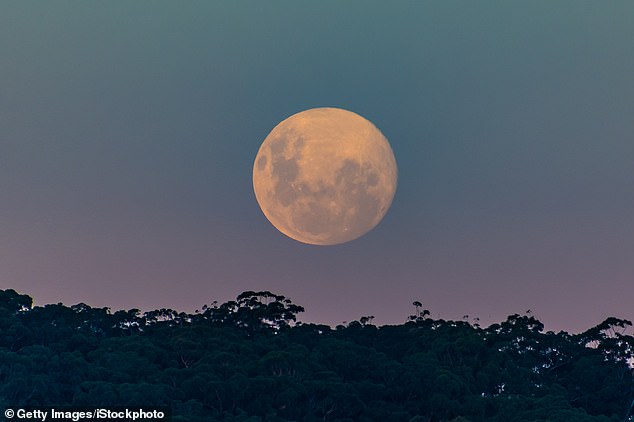Look up tonight! The Full Pink Moon reaches its peak tonight as our entire lunar satellite is illuminated by the sun
- The Pink Moon will officially peak at 00:49 BST on Wednesday morning
- It doesn’t really look pink, but looks full and bright in the night sky
If you enjoy stargazing, make sure you reserve this evening in your diary.
Tonight the Full Pink Moon will reach its peak as our entire lunar satellite is illuminated by the sun.
Despite its nickname, the moon doesn’t really look pink.
Instead, the name comes from the herb moss pink, one of the earliest widespread flowers of spring.
“Other names for this moon are the Sprouting Grass Moon, the Egg Moon, and in coastal tribes the Fish Moon, because the shad would swim upstream to spawn,” NASA explained.
If you enjoy stargazing, make sure you reserve this evening in your diary. Tonight the Full Pink Moon will reach its peak as our entire lunar satellite is illuminated by the sun
Full moons occur about once a month, when the moon is opposite the sun as seen from Earth.
This alignment reveals the dayside of the moon, making it appear full and bright in the night sky.
The Pink Moon will officially peak at 12:49 AM BST on Wednesday morning (7:49 PM EDT on Tuesday evening in the US).
“The moon will appear full at this time for about three days, from Monday morning to Thursday morning,” NASA explained.
The Maine Farmers’ Almanac began publishing “Indian” names for full moons in the 1930s, and these are now widely known and used around the world.
April’s full moon is commonly called the Pink Moon, according to this almanac, but you may also hear people call it the Pisces Moon, the Egg Moon, or the Grass Moon.

April’s full moon is commonly called the Pink Moon, according to this almanac, but you may also hear people calling it the Fish Moon, the Egg Moon, or the Grass Moon
In the Hebrew calendar this is also the Pesach, or Pesach moon, while for Buddhists this is the Bak Poya.
The Hindu lunisolar calendar has a number of variations, although for most regions this full moon corresponds to the Hanuman Jayanti festival, the celebration of the birth of Lord Hanuman.
Meanwhile, this full moon is in the middle of Shawwal, the tenth month of the Islamic calendar, and in the middle of the third month of the Chinese year of the dragon.
“Wearing appropriate festive celestial attire is encouraged in honor of the full moon,” NASA added.
‘Enjoy the early flowers and sprouting grass of spring, get an extra seat at the table and prevent wars from breaking out!’

